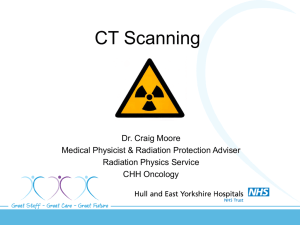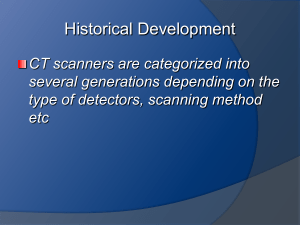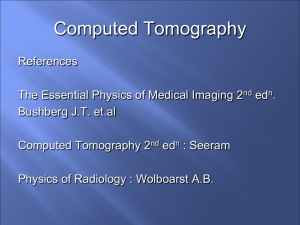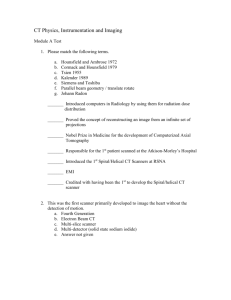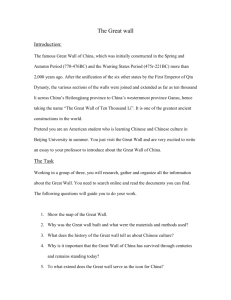CT1 - hullrad Radiation Physics
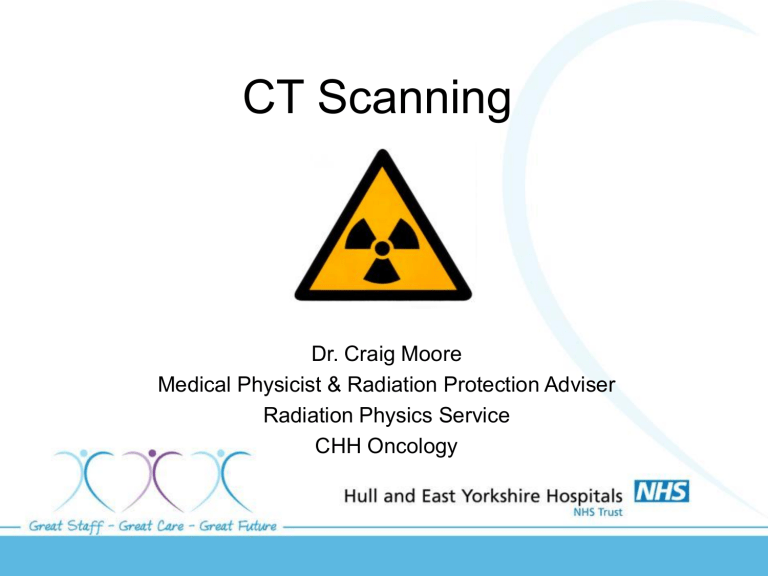
CT Scanning
Dr. Craig Moore
Medical Physicist & Radiation Protection Adviser
Radiation Physics Service
CHH Oncology
Brief History of CT Scanning
First CT Scanner - 1972
• Originally called CAT
• A = axial
• 80 x 80 resolution
• 4 min. per rotation
• 8 grey levels
• overnight reconstruction
Here and Now
• 512 x 512 or 1024 x 1024 resolution
• Sub second rotation
• 4096 grey levels
• 100’s slices per rotation
Components of a CT Scanner
Principal components of CT scanner
• X-ray tube, collimator, and detector array on a rotating gantry
• Rotation axis is referred to as Z axis
• Fan beam wide enough to cover patient crosssection
• Narrower width in the z-axis
• Behind the patient is a bank of detectors
• Patient lies on a couch that is moved longitudinally through the gantry
X-ray Tube
• Tube parallel to patient movement – minimise anode heel effect
• X-rays are produced by firing electrons at a metal target – typically tungsten
• Capable of producing long exposure times at high mA – get very hot (require heat capacities up to 4MJ and active cooling mechanisms)
• Continuous scanning limited to around 90s
• Focal spot size typically 0.6 - 1mm
• Beam heavily filtered (6-10 mm Al filters) to optimise spectrum
• Stops attenuation coefficients varying with depth via beam hardening
Collimation and Filtration
• Want a monoenergetic beam to avoid beam hardening artefacts
– As beam passes through patient low energies are filtered
– This results in the apparent reduction of attenuation and CT number of tissues
– Computer reconstruction assumes monoenergetic beam
– Not possible with X-ray tubes so they are heavily filtered
– At least 6 mm aluminium or copper
– Some manufacturers use shaped filters such as bow-tie filters to even out the dose distribution (conform to the shape of an elliptical patient)
• Pre-patient collimator is mounted on the Xray tube
– Beam is approx 50cm wide to cover cross section of patient
– The size is variable in the z-axis
– Multi-slice scanners between 0.5 and
40 mm thick beams
• Post patient collimation is not used with multi-slice scanner
The Tube & Collimators
Detectors
• Requirements:
– Small enough to allow good spatial resolution
– Up to 1000 detectors per scanner
– Typically 1.5 mm width but can be a small as 0.5mm
– High detection efficiency
– Fast response
– Wide dynamic range – massive variation in X-ray intensity
– Stable and noise free
– No afterglow
– There needs to be separation between detectors to prevent light crossover
• This reduces efficiency from 98% to 80%
Detectors
Xenon v Solid State
• Xenon
– Single detector chamber sub-divided by electrodes
– No longer used in multi-slice scanners
• Solid state
– Detector array made up of individual elements
– Scintillant such as cadmium tungstate and a silicone photodiode
– Rare earth ceramics or bismuth germanate
Generations of CT Scanner
CT Imaging
• Conventional radiography suffers from the collapsing of
3D structures onto a 2D image
• However, CT scanning has extremely good low contrast resolution, enabling the detection of very small changes in tissue type
– Almost true depiction of subject contrast
• CT gives accurate diagnostic information about the distribution of structures inside the body
• Generation of images in transaxial section
– Perpendicular to the axis of rotation of the X-ray tube about the body
– Perpendicular to the craniocaudal axis of patient
Number of detectors and projections
• Typically, for a 3 rd generation scanner:
– 650 – 900 detectors
– 1000 to 2000 projections per rotation
Collapse of 3D Data into 2D Plane
Image contrast 2:1
• Planar imaging
– 2D representation of 3D
Distribution of Tissue
– No depth information
– Structures at different depths are superimposed
• Loss of contrast
Subject Contrast 4:1
X rays
Typical CT Image
CT Images
• Commonly calculated on 512x512 matrix, but 256x256 and
1024x1024 are also used
• Each pixel is more accurately described as a voxel, because it has depth information
• The value stored in each voxel is referred to as the CT number which is related to the attenuation of a particular tissue:
– CTn = 1000 x (µt - µw)/ µw
• Sometimes referred to as
Hounsfield Units
• Each CT number is assigned a certain shade of grey in the resulting image
• CT number represents x-ray attenuation coefficient of the corresponding voxel within the patient
CT Numbers
Tissue
Bone
Muscle
Brain (grey matter)
Brain (white matter)
Fat
Lung
Range of CT Numbers
500-3000
40-60
35-45
20-30
-60 to -150
-300 to -800
Image Display
• CT image represented by a range of CT numbers from -1000 to + 3000 (ie
4000 levels of grey)
• Human eye dose not have the capacity to distinguish so many grey levels
• If 4000 shades of grey displayed altogether there would be very little difference between different tissues
Window Width and Level
• The appearance of the image on the screen can be changed by altering the window width and level
• Window width refers to the range of CT numbers selected for display
• This range of CT numbers is centred at a particular level called the window level
– e.g. if imaging bone window level should be ~1000
• Can spread a small range of CT numbers over a large range of grayscale values
Window Level –593
Window Width 500
Good contrast in lungs
Only see CT numbers
+/- 250 around -593
Window Level –12
Window Width 400
Good soft tissue contrast
Only see CT numbers +/-
200 around -12
How do we get the images?
• Tube and detector rotate smoothly around the patient
• X-rays are produced continuously and the detectors sample the X-ray beam approx
1000 times during one rotation
• Typically 2 to 4 revolutions per second
• In reality not always parallel to detectors
• Each voxel is traversed by one or more x-ray beams for every measurement (1000 per rotation)
• Number of measurements taken in single axial section depends on
– number of detectors
– Number of samples per rotation
• Assume 800 detectors measured at 0.5
° intervals per 360 ° rotation
• This is 576,000 measurements
• More than needed as we only need 260,000 measurements (512 x 512)
How do we get the picture?
• Back Projection
– Reverse the process of measurement of projection data to reconstruct image
– Each projection if smeared back across the reconstructed image
Back Projection – the basics
•
Consider cylindrical uniform body with a hole down the centre
•
A beam passing through this body from one direction will have a transmitted profile in its central region
•
This single measurement cannot determine the position of the hole other than identifying that it is in the line of the pencil beam passing through the centre of the body
•
Pixel values along this line are decreased by the amount of attenuation measured
•
These values are projected back along the field of view
• A second projection at 90 ° provides a second band of grey
• This is then projected back across field of view
• Progressive projections are shown in the final figure – a star like pattern
•
We now have an image that looks similar to what we are scanning
3
6
3
3
3 6
Back Projection
3
3
6
3
• Back Project each planar image onto three dimensional image matrix
6 3
1
1
3
1
2
2
6
2
1
1
3
1
Back Projection
• Back Project each planar image onto three dimensional image matrix
3
6
3
3 6 3
2 1 3 1
3
1 2
3
1
2 1 2 3 2
Back Projection
• Back Project each planar image onto three dimensional image matrix
3
6
3
3
4
6
4
6
6
8
6
3
4
6
4
3 6 3
Back Projection
3
6
3
• Back Project each planar image onto three dimensional image matrix
3
6
3
3
4
6
4
6
6
8
6
3
4
6
4
3 6 3
Back Projection
3
6
3
• Back Project each planar image onto three dimensional image matrix
Back Projection
• More views – better reconstruction
• 1/r blurring, even with infinite number of views
Filtered Back Projection
• Back projection produces blurred transaxial images
• Projection data needs to be filtered before reconstruction
• Different filters can be applied for different diagnostic procedures
– Smoother filters for viewing soft tissue
– Sharp filters for high resolution imaging
• Back projection same as before
– Data from neighbouring beams are used
– Some data is subtracted
– Some data is added
• Filters are convolved with the blurred image data in
Fourier Space
Filtered Back Projection
Filtered Back Projection
• Filter planar views prior to back projection
• Correction of 1/r blurring requires
‘Ramp’ Filter
– Gives increasing weight to higher spatial frequencies
– Amplifies Noise
1 signal
0.8
0.6
0.4
0.2
SPECT FIlters
0
-0.2
0 0.2
0.4
0.6
0.8
Frequency (fraction of Nyquist)
1
Ramp
Shepp-Logan
Modified
Shepp_Logan
Hanning
Hamming
Butterworth
Filtered Back Projection
• In Practice
– Use modifications of Ramp Filter
– Compromise between Noise and Spatial
Resolution
SPECT FIlters
1
0.8
0.6
0.4
0.2
0
-0.2
0 0.2
0.4
0.6
0.8
Frequency (fraction of Nyquist)
1
Ramp
Shepp-Logan
Modified
Shepp_Logan
Hanning
Hamming
Butterworth
Problems with Filtered Back
Projection
• Back projection is mathematically correct, but real life images require Filtered Back
Projection
• Back Projection can introduce noise and streaking artefacts
– Not good with attenuation correction
• Filtered Back Projection can reduce noise and artefacts, but may degrade resolution
Iterative Reconstruction
• Been around for years but only recently has computing power meant IR can be used in practice
• A raw image is taken, this is compared to a ‘perfect image’ and adjusted a little
• This process is repeated until the desired level of image quality is achieved
Helical and Multi-Slice Scanning
Helical Scanning
• Have discussed simplest form of CT scanning
– Can produce transaxial slices with the patient being moved along the z-axis between each rotations
– ‘Step and shoot’
– This is now very rare
• Helical scanning is now the standard
– Slip rings
– Continuous table feed through gantry
Helical Scanning
• Slip ring technology
– X-ray tube has to be supplied with constant power
– Detectors have to pass signals to computer
– Not possible if gantry was wired – cables would become entangled and overstretched
– Slip ring is a metal ring mounted on the gantry
– Good connection while the gantry is free to rotate
First we need the ‘scout view’
• Scout views are needed prior to the scan
• Performed to allow the planning of the CT sequence
• Scout views are produced lines by line at a fixed projection angle
– Typically AP
Helical Scanning
• Patient moves continuously through the gantry as the X-ray tube and detectors rotate
• Continuous acquisition of data in a single exposure
• Can be visualised as a ribbon wrapped around the body
• This technology minimises slice misregistration
Contiguous scan
Helical Scanning
• The position at which sections can be reconstructed can be anywhere within scanned volume other than at the ends
• For example:
– 300 mm long volume scanned
– 10 mm slice width
– Pitch = 2
• Only 15 rotations required
• From the measured data, 30 contiguous slices, each
10mm thick can be reconstructed (for a single slice scanner)
• For thinner slices we need multi-slice scanners
Advantages of Helical Scanning
• Speed
– No need to pause between scans for table movement
– Pitches greater than 1 allowed (reduction in dose)
– Longer scan lengths within breath hold
– Reduced patient movement artefacts
– Increased throughput
– Reduced use of contrast medium
Disadvantages of Helical Scanning
• Broadening of Slice profile
– Effective slice thickness increases – poorer z axis resolution
– Higher noise
• Helical artefacts not seen in axial scanning
• Possibility of very high dose if pitch < 1
• Lot of tube heating and loading
Multi Slice CT
Multiple detectors in single row
Remember!!
Multislice CT
• In its original form, CT scanning was twodimensional – 2D slices through the body
• True 3D imaging requires isotropy
– Voxel size must be equal in all directions
• Under these circumstances, data generated in a 3D matrix can be reconstructed in any plane
Multislice CT
• Voxel size in axial plane is dependent on matrix size and field of view
• Typically 1mm
• Single slice helical scanners have the capability of collimating the beam width (in the patient direction) to 1mm, but this is restricted by scan time
• Not possible in practice so we need to have multislice technology
Multislice CT
• Key to 3D scanning is the multislice scanner
• These scanners use solid state detectors with multiple rows of detectors
• Typical configuration for an 8 slice scanner
– 12 curved detector rows
– Each row has approx 800 detectors
– Each row has minimum possible gap between them
– Central rows have approx half the length of 2 outer rows
– Length of central rows 0.5 – 1mm
– Rows can be used separately or in combination
Multislice CT
• Four possible combinations here are possible:
– (a) 8 x 1mm slices
– (b) 8 x 2mm slices
– (c) 4 x 4mm slices
– (d) 2 x 8mm slices
• Eight slice scanner here is capable of producing scans at four slice widths, 1,2,4, or 8mm
• In each case, slice width is determined by the detector size and by collimation
• Scanners up to 256 slices now available
Beam width is varied
Physical acquisition
Computer reconstruction
Single slice Multi slice Single slice Multi slice
3 rotations One rotation
Dose and Multi-Slice Scanners
• Considerations similar to those of single slice scanners
• Dose utilisation on z axis usually poorer than with single slice scanners
– X ray beam width is generally broader than the total imaged width
– Geometric efficiency down to 50% for very small slice thicknesses (sub mm)
Geometric Efficiency
Broader beam to negate the effect of penumbra
Extra beam/x = geo eff
Dose and Helical CT
• All helical scanning requires extra irradiation at the end of each run to obtain sufficient interpolation data to reconstruct the required volume
• On multi-slice scanners this extra length can be quite long
Helical & Multi-Slice in the UK
• Helical & Multi-Slice scanning represent significant steps forward in CT
– Better scanning of previous scans
– Expansion of workload
• Nearly all scanners sold in UK are multi-slice
• Technology is still advancing
– 32/40/64/256 slice scanners now available
– More slices in the future?
Next Lecture:
• Dosimetry
• Operator controls and affects on dose and image quality
• artefacts
